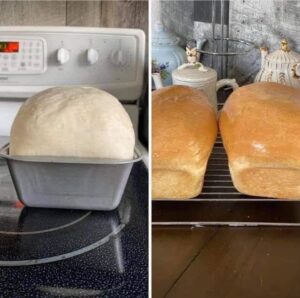
Introduction: The Ultimate Homemade Bread Recipe for Beginners and Beyond
There’s something undeniably soothing about baking bread from scratch, a slow, gentle process that allows you to connect with each step. This recipe isn’t just another bread recipe—it’s an invitation to create something warm and comforting for your family, to fill your home with the tantalizing aroma of freshly baked bread. Whether you’re new to bread baking or a seasoned pro, this recipe is sure to become a favorite. Simple ingredients, an easy process, and a reliable result make this the only bread recipe you’ll ever need.
Ingredients Overview
- Warm Water (2 cups): Essential for activating the yeast. Water should be warm but not hot—between 100-110°F—to allow the yeast to thrive.
- Sugar (1/4 cup): A touch of sweetness to balance the flavor and feed the yeast, which helps the dough rise beautifully.
- Yeast (1.5 tbsp): The star of the show! Active dry yeast will give the bread its lift and fluffy texture.
- Salt (1.5 tsp): Enhances flavor and controls yeast activity, giving you a more flavorful and well-structured loaf.
- Vegetable Oil (1/4 cup): Adds moisture and tenderness, giving the bread a soft crumb.
- All-Purpose Flour (5.5 cups): The foundation of the bread. All-purpose flour makes this recipe approachable, with a tender crumb and nice crust.
Step-by-Step Cooking Instructions
1. Dissolve the Sugar in Warm Water
In a large mixing bowl, add 2 cups of warm water (about 100-110°F) and stir in 1/4 cup of sugar until it dissolves completely.
2. Activate the Yeast
Sprinkle 1.5 tablespoons of yeast over the warm, sugary water. Let it sit for about 5-10 minutes until you see a frothy layer form—this means the yeast is active and ready to work its magic.
3. Add Oil to the Yeast Mixture
Pour 1/4 cup of vegetable oil into the yeast mixture and gently stir to combine.
4. Combine Dry Ingredients
In a separate bowl, mix 5.5 cups of all-purpose flour with 1.5 teaspoons of salt. This ensures the salt is evenly distributed.
5. Gradually Add Flour to Wet Mixture
Add the flour mixture to the yeast mixture, one cup at a time, stirring after each addition. Once the dough begins to form, switch to kneading.
6. Knead the Dough
Knead for 3-5 minutes on a lightly floured surface until smooth and elastic. The dough should be soft and slightly sticky but manageable.
7. First Rise
Place the dough in an oiled bowl, turning it over to coat all sides. Cover with a damp cloth or plastic wrap, and let rise in a warm area for about 1 hour or until it doubles in size.
8. Shape the Loaves
Once risen, punch down the dough to release air bubbles. Divide it into two equal parts and shape each into a loaf. Place in greased loaf pans.
9. Second Rise
Cover and let the loaves rise again for 30-40 minutes until they puff up and reach the top of the pans.
10. Bake
Preheat the oven to 350°F. Bake the loaves for approximately 30 minutes, or until golden brown on top.
11. Brush with Butter
Once out of the oven, brush the tops with butter for an extra touch of flavor and a soft crust.
Frequently Asked Questions (FAQs)
- Why is my bread dense?
If the dough isn’t kneaded enough or if it doesn’t rise properly, the bread may be dense. - Can I use whole wheat flour?
Yes! Substitute up to half of the flour with whole wheat, though it may make the bread slightly denser.
Helpful Tips for Perfect Bread
- Tip #1: Measure Flour Correctly
Spoon the flour into the measuring cup and level it off. Packing flour can lead to dry dough. - Tip #2: Don’t Overproof
Overproofed dough can collapse. Keep an eye on it and move on once it has doubled in size.
Storage and Reheating Tips
- Room Temperature – Store at room temperature in an airtight container for up to 3 days.
- Freezing – Wrap tightly in plastic wrap and place in a freezer bag. Freeze for up to 3 months.
- Reheating – Toast slices in the oven at 350°F for a few minutes.
Recipe Secrets for Amazing Bread
- Start with Good Yeast – Fresh yeast makes a difference. If unsure, do a quick test by proofing it in warm water with sugar before using.
- Use a Little Patience – Bread baking is as much about timing as it is about ingredients.
- Customize with Mix-Ins – Consider adding herbs, seeds, or cheese to the dough for a twist.
Additional Sections
Serving Suggestions
Try serving this bread with a spread of homemade herb butter or a drizzle of honey for a comforting breakfast treat. Toasted slices are perfect for making open-faced sandwiches topped with avocado or creamy ricotta.
Making the Recipe Your Own
This bread recipe can be adjusted to suit any occasion! Try dividing the dough into rolls, braiding it, or shaping it into a boule for a rustic touch.


